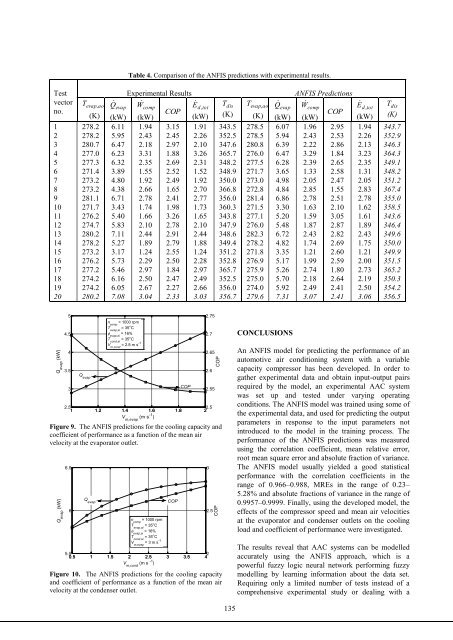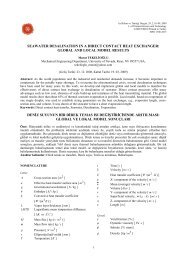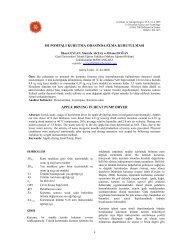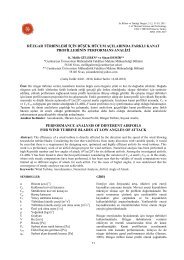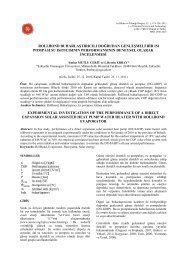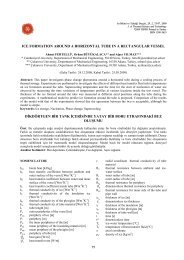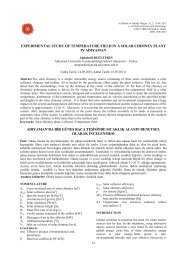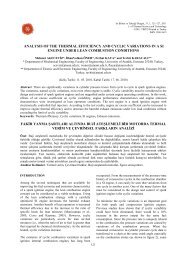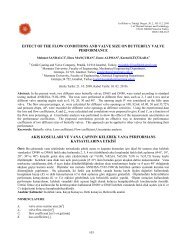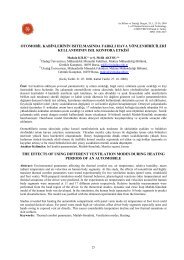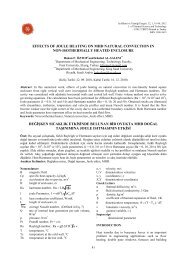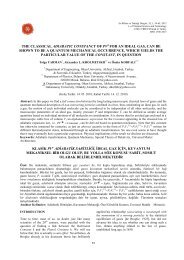modelling of an automotive air conditioning system using anfis
modelling of an automotive air conditioning system using anfis
modelling of an automotive air conditioning system using anfis
You also want an ePaper? Increase the reach of your titles
YUMPU automatically turns print PDFs into web optimized ePapers that Google loves.
Q evap<br />
(kW)<br />
COP<br />
Q evap<br />
(kW)<br />
COP<br />
Table 4. Comparison <strong>of</strong> the ANFIS predictions with experimental results.<br />
Test<br />
Experimental Results<br />
ANFIS Predictions<br />
vector T evap,<br />
ao Q evap W comp E <br />
d ,<br />
T<br />
tot dis T evap,<br />
ao Q evap W comp E <br />
d ,<br />
T<br />
tot dis<br />
no.<br />
COP<br />
(K) (kW) (kW)<br />
(kW) (K)<br />
COP<br />
(K) (kW) (kW)<br />
(kW) (K)<br />
1 278.2 6.11 1.94 3.15 1.91 343.5 278.5 6.07 1.96 2.95 1.94 343.7<br />
2 278.2 5.95 2.43 2.45 2.26 352.5 278.5 5.94 2.43 2.53 2.26 352.9<br />
3 280.7 6.47 2.18 2.97 2.10 347.6 280.8 6.39 2.22 2.86 2.13 346.3<br />
4 277.0 6.23 3.31 1.88 3.26 365.7 276.0 6.47 3.29 1.84 3.23 364.3<br />
5 277.3 6.32 2.35 2.69 2.31 348.2 277.5 6.28 2.39 2.65 2.35 349.1<br />
6 271.4 3.89 1.55 2.52 1.52 348.9 271.7 3.65 1.33 2.58 1.31 348.2<br />
7 273.2 4.80 1.92 2.49 1.92 350.0 273.0 4.98 2.05 2.47 2.05 351.2<br />
8 273.2 4.38 2.66 1.65 2.70 366.8 272.8 4.84 2.85 1.55 2.83 367.4<br />
9 281.1 6.71 2.78 2.41 2.77 356.0 281.4 6.86 2.78 2.51 2.78 355.0<br />
10 271.7 3.43 1.74 1.98 1.73 360.3 271.5 3.30 1.63 2.10 1.62 358.5<br />
11 276.2 5.40 1.66 3.26 1.65 343.8 277.1 5.20 1.59 3.05 1.61 343.6<br />
12 274.7 5.83 2.10 2.78 2.10 347.9 276.0 5.48 1.87 2.87 1.89 346.4<br />
13 280.2 7.11 2.44 2.91 2.44 348.6 282.3 6.72 2.43 2.82 2.43 349.6<br />
14 278.2 5.27 1.89 2.79 1.88 349.4 278.2 4.82 1.74 2.69 1.75 350.0<br />
15 273.2 3.17 1.24 2.55 1.24 351.2 271.8 3.35 1.21 2.60 1.21 349.9<br />
16 276.2 5.73 2.29 2.50 2.28 352.8 276.9 5.17 1.99 2.59 2.00 351.5<br />
17 277.2 5.46 2.97 1.84 2.97 365.7 275.9 5.26 2.74 1.80 2.73 365.2<br />
18 274.2 6.16 2.50 2.47 2.49 352.5 275.0 5.70 2.18 2.64 2.19 350.3<br />
19 274.2 6.05 2.67 2.27 2.66 356.0 274.0 5.92 2.49 2.41 2.50 354.2<br />
20 280.2 7.08 3.04 2.33 3.03 356.7 279.6 7.31 3.07 2.41 3.06 356.5<br />
5<br />
4.5<br />
4<br />
3.5<br />
3<br />
Q evap<br />
n comp<br />
= 1000 rpm<br />
T evap,ai<br />
= 35 C<br />
evap,ai<br />
= 16%<br />
T cond,ai<br />
= 35 C<br />
V m,cond<br />
= 2.8 m s -1<br />
COP<br />
2.75<br />
2.65<br />
2.55<br />
2.5<br />
1 1.2 1.4 1.6 1.8 2 2.5<br />
V m,evap<br />
(m s -1 )<br />
Figure 9. The ANFIS predictions for the cooling capacity <strong>an</strong>d<br />
coefficient <strong>of</strong> perform<strong>an</strong>ce as a function <strong>of</strong> the me<strong>an</strong> <strong>air</strong><br />
velocity at the evaporator outlet.<br />
6.5<br />
Q evap<br />
COP<br />
6<br />
2.5<br />
n = 1000 rpm<br />
comp<br />
T = 35 C<br />
evap,ai<br />
= 16%<br />
evap,ai<br />
T = 35 C<br />
cond,ai<br />
V = 3 m s -1<br />
m,evap<br />
5.5<br />
0.5 1 1.5 2 2.5 3 3.5 4 2<br />
V m,cond<br />
(m s -1 )<br />
Figure 10. The ANFIS predictions for the cooling capacity<br />
<strong>an</strong>d coefficient <strong>of</strong> perform<strong>an</strong>ce as a function <strong>of</strong> the me<strong>an</strong> <strong>air</strong><br />
velocity at the condenser outlet.<br />
2.7<br />
2.6<br />
3<br />
CONCLUSIONS<br />
An ANFIS model for predicting the perform<strong>an</strong>ce <strong>of</strong> <strong>an</strong><br />
<strong>automotive</strong> <strong>air</strong> <strong>conditioning</strong> <strong>system</strong> with a variable<br />
capacity compressor has been developed. In order to<br />
gather experimental data <strong>an</strong>d obtain input-output p<strong>air</strong>s<br />
required by the model, <strong>an</strong> experimental AAC <strong>system</strong><br />
was set up <strong>an</strong>d tested under varying operating<br />
conditions. The ANFIS model was trained <strong>using</strong> some <strong>of</strong><br />
the experimental data, <strong>an</strong>d used for predicting the output<br />
parameters in response to the input parameters not<br />
introduced to the model in the training process. The<br />
perform<strong>an</strong>ce <strong>of</strong> the ANFIS predictions was measured<br />
<strong>using</strong> the correlation coefficient, me<strong>an</strong> relative error,<br />
root me<strong>an</strong> square error <strong>an</strong>d absolute fraction <strong>of</strong> vari<strong>an</strong>ce.<br />
The ANFIS model usually yielded a good statistical<br />
perform<strong>an</strong>ce with the correlation coefficients in the<br />
r<strong>an</strong>ge <strong>of</strong> 0.966–0.988, MREs in the r<strong>an</strong>ge <strong>of</strong> 0.23–<br />
5.28% <strong>an</strong>d absolute fractions <strong>of</strong> vari<strong>an</strong>ce in the r<strong>an</strong>ge <strong>of</strong><br />
0.9957–0.9999. Finally, <strong>using</strong> the developed model, the<br />
effects <strong>of</strong> the compressor speed <strong>an</strong>d me<strong>an</strong> <strong>air</strong> velocities<br />
at the evaporator <strong>an</strong>d condenser outlets on the cooling<br />
load <strong>an</strong>d coefficient <strong>of</strong> perform<strong>an</strong>ce were investigated.<br />
The results reveal that AAC <strong>system</strong>s c<strong>an</strong> be modelled<br />
accurately <strong>using</strong> the ANFIS approach, which is a<br />
powerful fuzzy logic neural network performing fuzzy<br />
<strong>modelling</strong> by learning information about the data set.<br />
Requiring only a limited number <strong>of</strong> tests instead <strong>of</strong> a<br />
comprehensive experimental study or dealing with a<br />
135


